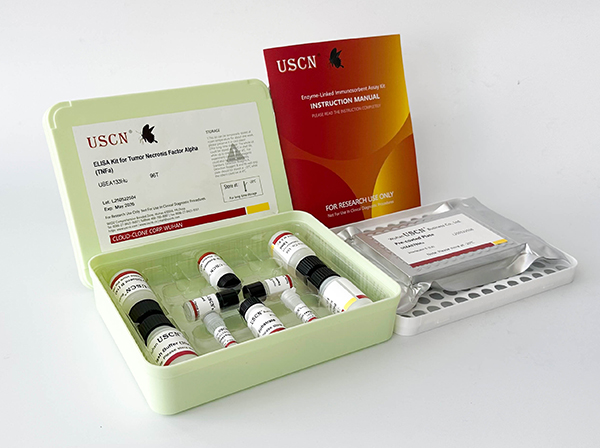CLIA Kit for Docosahexaenoic Acid (DHA)
Doconexent; Cervonic Acid
- Product No.UCCO623Ge
- Organism SpeciesPan-species (General) Same name, Different species.
- Test MethodCompetitive Inhibition
- Assay Length2h
- Detection Range3.9-1,000pg/mL
- SensitivityThe minimum detectable dose of this kit is typically less than 1.5pg/mL.
- Sample Typeserum, plasma and other biological fluids
- Download Instruction Manual
- UOM 48T96T 96T*5 96T*10 96T*100
-
FOB
US$ 377
For more details, please contact local distributors!US$ 539
For more details, please contact local distributors! US$ 2426
For more details, please contact local distributors! US$ 4582
For more details, please contact local distributors! US$ 37730
For more details, please contact local distributors!
Specificity of the CLIA Kit for Docosahexaenoic Acid (DHA)
This assay has high sensitivity and excellent specificity for detection of Docosahexaenoic Acid (DHA).
No significant cross-reactivity or interference between Docosahexaenoic Acid (DHA) and analogues was observed.
Recovery of the CLIA Kit for Docosahexaenoic Acid (DHA)
Matrices listed below were spiked with certain level of Docosahexaenoic Acid (DHA) and the recovery rates were calculated by comparing the measured value to the expected amount of Docosahexaenoic Acid (DHA) in samples.
| Matrix | Recovery range (%) | Average(%) |
| serum(n=5) | 84-104 | 88 |
| EDTA plasma(n=5) | 92-104 | 97 |
| heparin plasma(n=5) | 85-101 | 90 |
Precision of the CLIA Kit for Docosahexaenoic Acid (DHA)
Intra-assay Precision (Precision within an assay): 3 samples with low, middle and high level Docosahexaenoic Acid (DHA) were tested 20 times on one plate, respectively.
Inter-assay Precision (Precision between assays): 3 samples with low, middle and high level Docosahexaenoic Acid (DHA) were tested on 3 different plates, 8 replicates in each plate.
CV(%) = SD/meanX100
Intra-Assay: CV<10%
Inter-Assay: CV<12%
Linearity of the CLIA Kit for Docosahexaenoic Acid (DHA)
The linearity of the kit was assayed by testing samples spiked with appropriate concentration of Docosahexaenoic Acid (DHA) and their serial dilutions. The results were demonstrated by the percentage of calculated concentration to the expected.
| Sample | 1:2 | 1:4 | 1:8 | 1:16 |
| serum(n=5) | 80-105% | 78-97% | 80-103% | 93-102% |
| EDTA plasma(n=5) | 82-95% | 80-97% | 92-99% | 78-104% |
| heparin plasma(n=5) | 78-97% | 85-92% | 93-101% | 88-96% |
Stability of the CLIA Kit for Docosahexaenoic Acid (DHA)
The stability of kit is determined by the loss rate of activity. The loss rate of this kit is less than 5% within the expiration date under appropriate storage condition.
To minimize extra influence on the performance, operation procedures and lab conditions, especially room temperature, air humidity, incubator temperature should be strictly controlled. It is also strongly suggested that the whole assay is performed by the same operator from the beginning to the end.
Assay procedure summary of the CLIA Kit for Docosahexaenoic Acid (DHA)
1. Prepare all reagents, samples and standards;
2. Add 50µL standard or sample to each well.
And then add 50µL prepared Detection Reagent A immediately.
Shake and mix. Incubate 1 hour at 37°C;
3. Aspirate and wash 3 times;
4. Add 100µL prepared Detection Reagent B. Incubate 30 minutes at 37°C;
5. Aspirate and wash 5 times;
6. Add 100µL Substrate Solution. Incubate 10 minutes at 37°C;
7. Read RLU value immediately.
Test principle of the CLIA Kit for Docosahexaenoic Acid (DHA)
The microplate provided in this kit has been pre-coated with a monoclonal antibody specific to Docosahexaenoic Acid (DHA). A competitive inhibition reaction is launched between biotin labeled Docosahexaenoic Acid (DHA) and unlabeled Docosahexaenoic Acid (DHA) (Standards or samples) with the pre-coated antibody specific to Docosahexaenoic Acid (DHA). After incubation the unbound conjugate is washed off. Next, avidin conjugated to Horseradish Peroxidase (HRP) is added to each microplate well and incubated. The amount of bound HRP conjugate is reverse proportional to the concentration of Docosahexaenoic Acid (DHA) in the sample. Then the mixture of substrate A and B is added to generate glow light emission kinetics. Upon plate development, the intensity of the emitted light is reverse proportional to the Docosahexaenoic Acid (DHA) level in the sample or standard.
GIVEAWAYS
INCREMENT SERVICES
Related products
| Catalog No. | Organism species: Pan-species (General) | Applications (RESEARCH USE ONLY!) |
| UCPO623Ge11 | BSA Conjugated Docosahexaenoic Acid (DHA) | Immunogen; SDS-PAGE; WB. |
| UCPO623Ge21 | OVA Conjugated Docosahexaenoic Acid (DHA) | Immunogen; SDS-PAGE; WB. |
| UPAO623Ge01 | Polyclonal Antibody to Docosahexaenoic Acid (DHA) | ELISA |
| UCEO623Ge | ELISA Kit for Docosahexaenoic Acid (DHA) | Enzyme-linked immunosorbent assay for Antigen Detection. |
| UCCO623Ge | CLIA Kit for Docosahexaenoic Acid (DHA) | Chemiluminescent immunoassay for Antigen Detection. |
| ULMO623Ge | Multiplex Assay Kit for Docosahexaenoic Acid (DHA) ,etc. by FLIA (Flow Luminescence Immunoassay) | FLIA Kit for Antigen Detection. |



